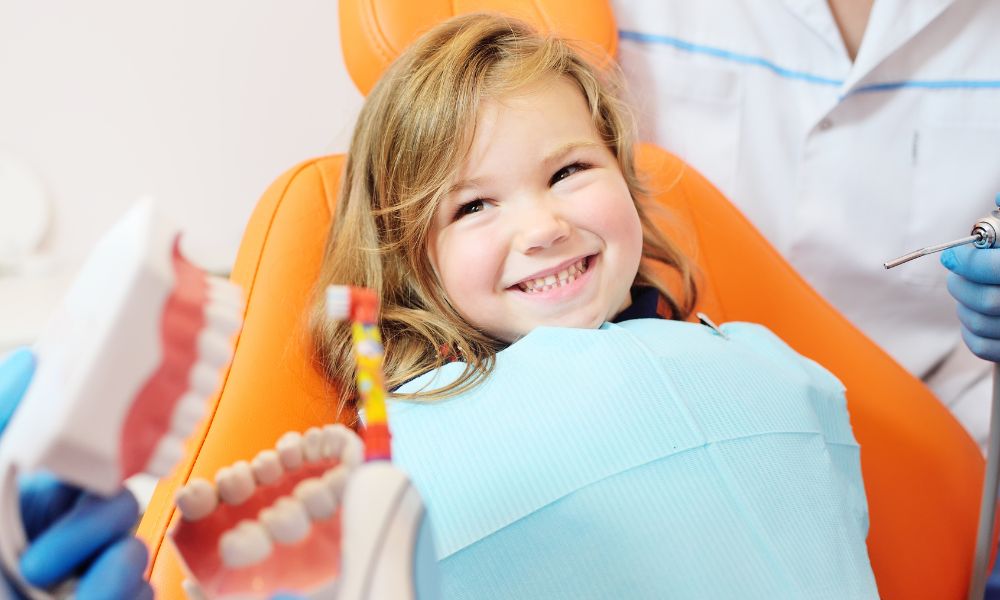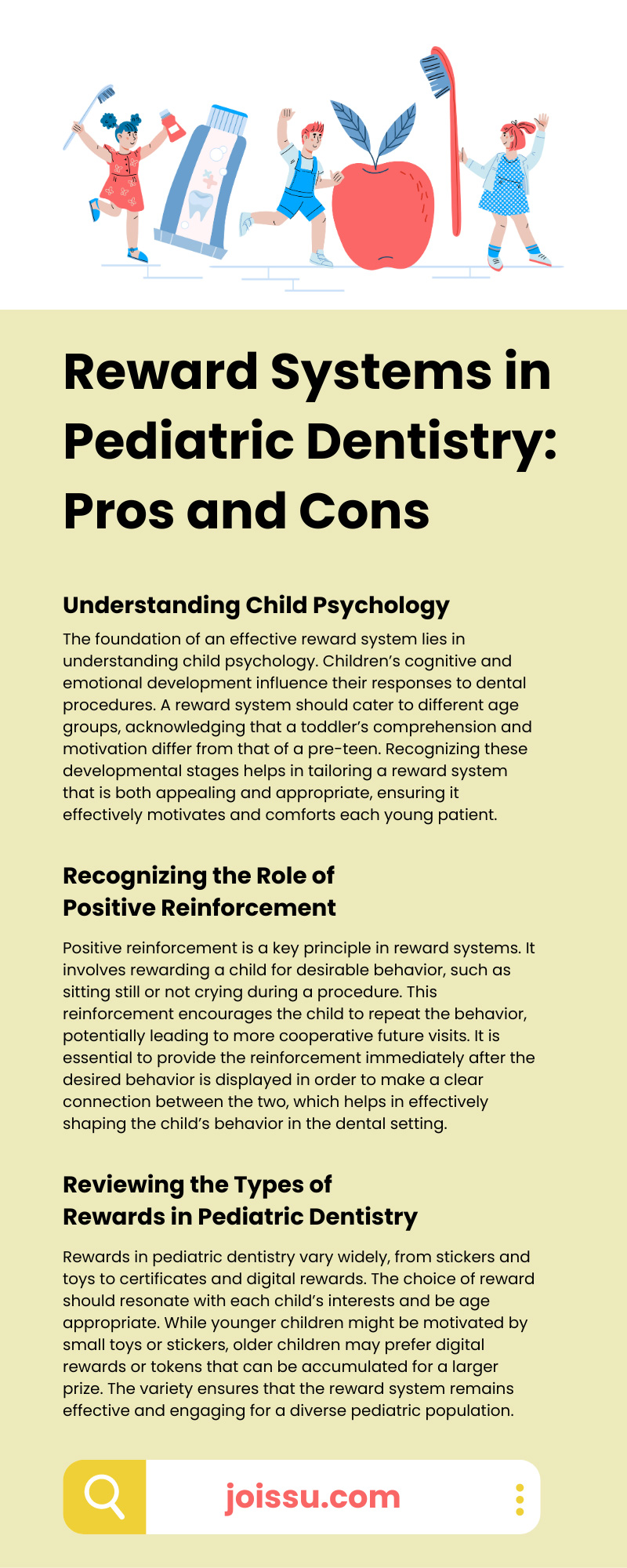
Reward systems in pediatric dentistry are a common practice aimed at encouraging cooperation and reducing anxiety in young patients. These systems range from verbal praise to tangible prizes, and their implementation can significantly impact children’s dental experiences. Understanding the nuances of these systems is crucial, as they balance effectiveness with ethical considerations. Read on to learn some pros and cons of reward systems in pediatric dentistry.
Understanding Child Psychology
The foundation of an effective reward system lies in understanding child psychology. Children’s cognitive and emotional development influence their responses to dental procedures. A reward system should cater to different age groups, acknowledging that a toddler’s comprehension and motivation differ from that of a pre-teen. Recognizing these developmental stages helps in tailoring a reward system that is both appealing and appropriate, ensuring it effectively motivates and comforts each young patient.
Recognizing the Role of Positive Reinforcement
Positive reinforcement is a key principle in reward systems. It involves rewarding a child for desirable behavior, such as sitting still or not crying during a procedure. This reinforcement encourages the child to repeat the behavior, potentially leading to more cooperative future visits. It is essential to provide the reinforcement immediately after the desired behavior is displayed in order to make a clear connection between the two, which helps in effectively shaping the child’s behavior in the dental setting.
Reviewing the Types of Rewards in Pediatric Dentistry
Rewards in pediatric dentistry vary widely, from stickers and toys to certificates and digital rewards. The choice of reward should resonate with each child’s interests and be age appropriate. While younger children might be motivated by small toys or stickers, older children may prefer digital rewards or tokens that can be accumulated for a larger prize. The variety ensures that the reward system remains effective and engaging for a diverse pediatric population.
Balancing Tangible and Intangible Rewards
While tangible rewards like toys and stickers are common, intangible rewards like verbal praise or a high-five can be equally effective. Balancing these two types of rewards is crucial. Tangible rewards might be more immediately gratifying, but intangible rewards can foster a sense of accomplishment and self-motivation. This balance helps promote a positive attitude toward dental care that extends beyond the immediate lure of a physical reward.
Determining the Cost-Effectiveness of Reward Systems
Implementing a reward system comes with associated costs, particularly with tangible rewards. Dental practices must consider the financial aspect of maintaining a reward inventory. However, the long-term benefits of improved patient cooperation and reduced anxiety can offset these costs. A well-designed reward system can lead to more efficient appointments and a higher rate of patient return, which can be beneficial from a business perspective.
Noting the Impact on Patient Cooperation
One of the primary benefits of a reward system is improved patient cooperation. A well-implemented system can turn a potentially frightening experience into a positive one, encouraging children to be more cooperative during their dental visits. This cooperation not only makes dental procedures easier for the practitioner but also contributes to each child’s overall oral health by enabling thorough examinations and treatments.
Reducing Dental Anxiety
Dental anxiety is a common issue in pediatric patients. Reward systems can play a significant role in reducing this anxiety by providing a distraction and a positive focus. Knowing that there is a reward at the end of an appointment can help a child overcome fear and apprehension, leading to a more relaxed and less stressful experience for both the child and the dentist.
Encouraging Regular Dental Visits
Regular dental visits are crucial for maintaining oral health. An effective reward system can motivate children to attend these appointments regularly. The anticipation of a reward can make the prospect of a dental visit more appealing, potentially reducing missed appointments and encouraging consistent oral healthcare practices from a young age.
Addressing Ethical Considerations
While reward systems have many benefits, ethical considerations must be addressed. It’s important to ensure that rewards do not become bribes and that they are not used to coerce a child into undergoing a procedure they are uncomfortable with. The rewards should be seen as a positive reinforcement for bravery and cooperation rather than a means to an end.
Customizing Rewards to Individual Needs
Tailoring rewards to each child’s unique preferences and needs is a critical aspect of pediatric dentistry. Children have diverse backgrounds, temperaments, and health conditions, making a one-size-fits-all approach ineffective. For instance, a child with sensory processing issues may prefer a quiet, gentle word of praise over a brightly colored toy.
Similarly, for a child who has had previous traumatic dental experiences, the reward might be as simple as a break during the procedure. Understanding and respecting these individual differences not only makes every reward more meaningful but also builds trust and rapport between the dentist and the young patient.
Understanding Long-Term Impact on Behavior
The influence of a well-designed reward system extends far beyond the dental chair. Positive reinforcement during early dental visits can instill a lifelong appreciation for oral hygiene and regular dental care. Children who have pleasant experiences at the dentist are less likely to develop dental phobias, making them more likely to maintain regular check-ups into adulthood. This proactive approach to dental health can lead to better overall oral health outcomes and a reduced need for invasive procedures later in life. It’s an investment in shaping responsible, health-conscious adults.
Following Professional Guidelines and Best Practices
Adhering to professional guidelines and best practices is paramount when implementing a reward system. This involves staying updated with the latest pediatric dental research, understanding the psychological aspects of child behavior, and being aware of the ethical boundaries in patient care. Dental professionals should regularly evaluate and adjust their reward systems based on feedback, new research findings, and their own professional experiences. By doing so, they ensure that their approaches remain effective, ethical, and aligned with the best interests of their young patients.
Sourcing Rewards: Wholesale Light-Up Toys
For dental practices looking to incorporate tangible rewards, sourcing products like wholesale light-up toys can be both economical and appealing. These toys are often a hit with children, providing a moment of delight and distraction from any dental anxieties.
However, it’s crucial to vet these products for safety, ensuring they are nontoxic, do not pose choking hazards, and comply with health standards. Practices should also consider the variety and appeal of these toys, regularly updating their selection to maintain interest and excitement. By carefully selecting and diversifying their rewards, dental practices can enhance the overall effectiveness of their reward systems.
Now that you know more about the pros and cons of reward systems in pediatric dentistry, it’s clear that, when used effectively, rewards can enhance the dental experience for children. The key is to create a balanced, ethical, and customized system that caters to the diverse needs of pediatric patients.








